
Even till now, people of Central Java believe in a mysterious Queen of the Seas ……
This is the first report on the Legend of the South Sea Queen Kanjeng Ratu Kidul.. API will add more to this report as the investigation and research continues……
THE LEGEND OF THE SOUTH SEA QUEEN
The high cliffs of Jawa's southern coast go straight into the Indian Ocean. This is the domain of Kanjeng Ratu Kidul, the mighty Queen of the South Sea, which is th wife as well as the protectional spirit of the rulers of the Jawanese kingom of Mataram.
Following the 19th century chronicle Babad Tanah Jawi, the prince of Pajajaran, Raden Joko Suruh, met a hermit which ordered him to found the kingdom of Majapahit in East Jawa. Joko Suruh discovered that the hermit in fact was a beautiful Lady, and fell in love with her. She rejected him, because she really was his aunt Ratna Suwida, who had lived in the mountains to meditate ever since she was a young girl. She told the prince she would soon leave to the southern coast of Jawa, to be the ruler over the spirit-world. When the descendants near the Gunung Merapi – not far from the southern coast – founded a principalty, she would marry the successive rulers.
Generations later, Panembahan Senopati, founder of the second Mataram principalty, went back to the southern coast to prepare an attack on the principalties at the northern coast. Kanjeng Ratu Kidul, who listened to his meditation, promised to help him. During three days and nights he worked on the secrets of army and rule – and the difficult game of love – in the undersea palace of Ratu Kidul. At Parangkusomo, south of Yogya, he came to the surface again. The story goes that Ratu Kidul had communion with all successors of Senopati. Every year representatives of the palaces in Solo and Yogya honour her at this spot.
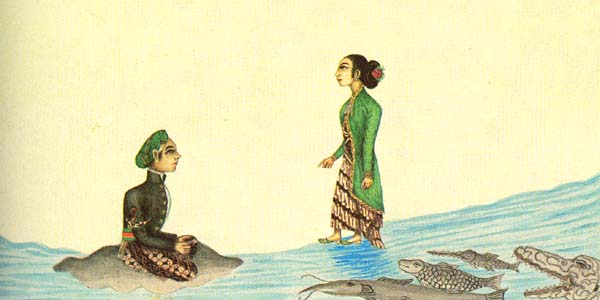
Senopati, founder of Java's Mataram dynasty, accompanies Ratu Kidul to her underwater palace.
The first sultan of Yogya, Hamengku Buwono I, ordered the construction of the difficult fortress and royal court, Taman Sari, with low ponds, and tunnels, surrounded with an artificial lake. It can be said that this is a replica of the undersea principalty of Ratu Kidul. In the space below the surface, known as sumur gumuling, the sultan is believed to have contact with the goddess every year.
This version account how Ratu Kidul becomes a spirit queen:
The following story is about Nyai Loro kidul or “Ratu kidul” (Queen Kidul) as she is also known, the most beautiful and powerful goddess of Indonesia’s southern seas.
According to the legend, Nyai Loro Kidul was the mortal daughter of a powerful ruler-king of west Java. This king’s concubines jealous of her beauty would have used black magic to turn her into an ugly and old witch. (Other stories say it was a bad stepmother who cast a spell to give her leprosy) In anyways, because of her ugliness, she was forced to leave the palace when she started to wonder through the forest without direction. When she finally got to the ocean, she stopped to rest and fell asleep. She dreamt that she would be cured of her ugliness if she entered the water and drowned herself. She did it ant then became the powerful goddess of the Indonesia’s southern seas.
Following the tradition, her favorite color is green and she is attracted to those who wear this color inside her marine kingdom. Besides that, this beautiful but sometimes evil goddess has a particular interest in surfers, not only because she has got absolute power and control over the waves of Indonesia’s southern seas but also for been known to take young men and turn them into her slaves or lovers.
Both Javanese and sundanese people avoid wearing green when they go to her beaches and very often mothers lock their sons at home in nights when a sacred dance in homage to Nyai Loro Kidul is performed.
Even for those who are not superstitious, it is always good to be careful. There are recorded stories about surfers and other people who ventured in her waters wearing green and afterwards were troubled by some disgrace.
In one story published in “The Jakarta Post” in September 1995, a man who challenged this taboo wore a green t-shirt at one beach o the coast of Cilacap on west Java. “he can not look backwards now, because all he sees are monsters.” reported the post.
In another occasion, in Jan 1993, a huge fire burned completely the “Grand Bali Beach Hotel” in Sanur, Bali, leaving only 5% of the hotel undamaged. Only one room, room 327, stayed untouched by both the flames and smoke. Coincidentally room 327 was a “private” room that has always been specially reserved for the legendary sea queen.
To the balinese this was a clear message that the had not yet done enough work to please her majesty. Soon after they understood this sign, priests quickly start making religious offerings and prayers to prevent and calm down possible future hysterical attacks.
Since then the hotel has been rebuilt and room 327 has been redecorated with a lot more generosity and luxury.
NB: There is another room reserved for the Queen at 2401 (see report below)
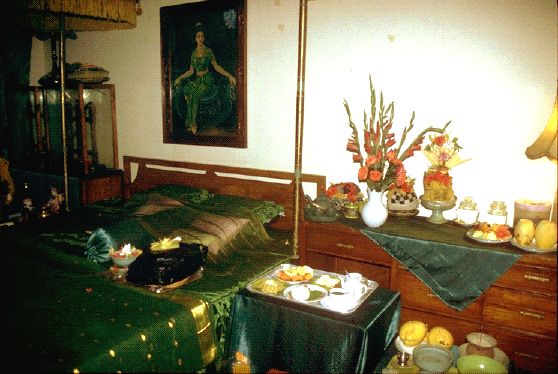
Room 2401 – Bali Beach Hotel (noted the green colour)
In another similar account, in 1966, the then sultan Hamengku Buwono was expected for the opening ceremony of the Sumudra Beach Hotel in west Java. The night before the hotel’s grand opening, he was visited by an old man (ancient). According to Jeffrey A. McNelly and Paul Spencer Wachtel (authors of the book “Soul of the Tiger”, 1988) “The old man told the prince that he had a dream the previous night in which an old lady said she wanted her offerings. She was dressed in green.”
“The sultan thanked the man but explained that he would not make an offering since he was attending the hotel opening in his civilian capacity as minister of defense and he wanted to separate affairs of state from the mystical duties of the palace.”
Shortly after the ancient left, there was a huge roar at the hotel, “like ten locomotives were coming towards the beach front terrace.” Out of nowhere came a 10 feet high wave from a previously calm waters, sweeping away the hotels buffet table, soaking the guests and taking out a couple of trees.
Soon after came the offerings and today, as at the Grand Bali Beach, the Sumudra Hotel has a special room for Nyai Loro Kidul.
However another version tells that Sukarno (Indonesia first president) received a message when he was praying to spare one room for the queen, and under Sukarno's instructions, Room 308 has always been reserved for the queen.

Reserved Room for the Queen – Samudra Hotel Room 308
Despite such negative incidents, the sea goddess is not always bad. According to the authors McNeely and Wachtel “She divides her time between land and sea, and appears as a youthful nymph in the first half of the month and as an ugly hag in the second half. Javanese believe her demeanor is at times bitter and malevolent, and that she can only be propitiated by strict observance of complex rituals. Yet with the fickle nature so typical of both Asian women and Asian gods, when treated properly she can also bestow great favors, such as ensuring a good catch to a fisherman.” Or even produce perfect waves for a group of surfers?!
The Javanese also believe that every ruler-king of Java must compulsively accept Nyai Loro Kidul as his wife and make homage to her every year with proper offerings that usually are made of parts of women’s clothes and pieces of hair and nails of the sultan.
Until the present days fishermen from Java and Bali make a ceremony every year in her honor. They believe this help to prevent disasters. They also believe that before entering the waters she rules, everybody should ask her permission otherwise something bad can happen.
Sultan Hamengku Buwono X and Kangjeng Ratul Kidul

Sultan Hamengku Buwono X was crowned on March 7, 1989 after the death of the popular Hamengku Buwono IX, who once served as Vice President under Suharto.
Just after the coronation was the main event Wiyos-Dalern Kirab, the customary circumambulation
of the city by the newly enthroned sultan.
The procession was headed by the religious retainers, then palace guards, horses carrying
heirlooms, princes on horseback, and the Golden Coach itself, carved with dragons and
adorned with garlands of jasmine and floral rosettes,
It was not the modern but the mystical dimension of the sultan that was brought out by
the stories on the kirab. There had been a certain amount of discussion in advance about the
fact that the queen would not ride in the carriage with her husband. During the circuit, she
sat with her guests in the Pagelaran, dressed in a long golden-yellow kebaya. In his carriage,
the sultan sat against the right-hand side, and his brother faced him, sitting cross-legged.
What was the reason for this arrangement? A line of explanation was derived from an
adventure that befell Prince Prabukusumo, who had been riding ahead of the carriage.
He claimed to have seen a beautiful woman dressed in greenish yellow enter the carriage. Later,
as the procession came past the post office, his horse reared and he was thrown. Strangely,
he was unhurt, "I felt as if I had been caught in someone's lap/'30 His clothing was slightly
torn, and his keris had come out of its sheath. This he took for a sign that the keris was not
appropriate for that occasion, and he gave it to someone for safekeeping. After that, the
horse behaved perfectly. The prince added that he had earlier seen a woman's form between
the two banyans on the North Square and that the horse had become skittish there as well.
Joyokusumo said that he had felt "something" in the carriage, and HB X just smiled mysteriously.
The Sunday papers carried a close-up photograph of the sultan in the carriage
shrouded in what was termed a "mysterious mist." To photographers, the blur was more a
"technical error," but the speculation by then had begun to congeal into legend.
These odd hints and allusions could mean only one thing: the sultan had been sitting to
the right of the carriage so that Kangjeng Ratu Kidul, the sea goddess, could sit on his left. It
was she who Prabukusumo saw climbing into the carriage. The figure of a sea goddess with
a capricious temperament is found not only in Java but in many regions of Southeast Asia,
but what matters here is that Kangjeng Ratu Kidul, Queen of the South Sea, is believed to act
as consort to the kings of Java. To her are made the offerings each year at Parangkusumo
and to her is attributed the origin of the sacred Bedhaya Ketawang, which describes her
amorous encounter with the founding father of Mataram, Senopati, or his grandson Sultan
Agung.
Ratu Kidul is believed to attend the annual performances of Bedhaya Ketawang at
the palace of the Susuhunan in Surakarta. In Yogya, the Bedhaya Semang, also offered to her,
ceased to be performed around 1914, but the myth is still powerful. Before he died, HB DC
claimed to have seen her and said that he used to address her as Grandmother (Eyang),
although she appears as a young girl when the moon is new.
Despite a sophisticated understanding of her role in legitimizing strategies to strengthen
the Javanese kingdoms, she is still treated literally, as the reaction to the kirab shows. There
was difficulty with the status of the legend for HB X, who had taken a strong stand about
only having one wife. If this was to be the case, what about Ratu Kidul? The Queen, said
some, had been left behind to let her husband be joined by his spirit wife. Local historians
countered that the sultan used to ride with the Dutch governor on his left; no one explained
why the present governor of of Yogya had not been invited to take his place. The matter was
even taken up by the national weekly, Tempo, and the sultan was asked about Kangjeng
Ratu Kidul. His reply was ambiguous: "How you take it is up to you. For my part, there's
no need for everyone to know what I experienced. I don't have to tell everyone things like
that." Perhaps the best comment on the conundrum was the remark made by one of the
palace widows, an aunt to the sultan, who drily observed that the sultan was sitting to the
right to make space for where the Dutch governor would have been—and Kangjeng Ratu
Kidul sat on his lap.
Source: Felicia Hughes-Freeland : A Throne for the People: Observations on the Jumenengen of Sultan
Hamengku Buwono X
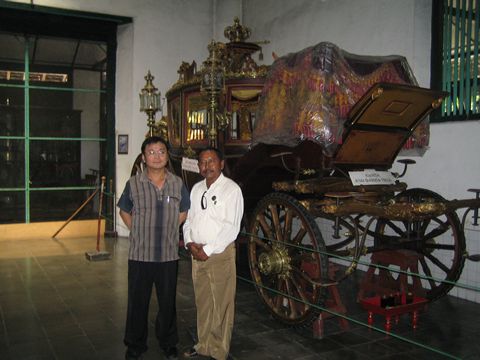
API Raymond with Notosuyono, Kraton Palace guard, posing in front of the golden carriage that
carried Sultan Hamengku Buwono X during the kirab
Notosuyono is a palace guard who was behind the carriage at the time of kirab. He told API Raymond that
the noted a powerful fragrance coming from the carriage at that time. Asked if he saw
Ratul Kidul, he said, "You cannot see with your eyes open, you can only see with the heart"
The same powerful fragrance was felt and noted at the coronation of Sultan, not only by members of the
royal family but also by many others in attendance.
Sultan Hamengku Buwono IX and Kangjeng Ratul Kidul
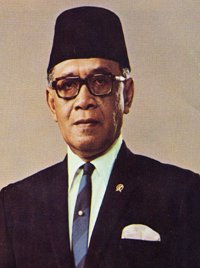
The late Sultan Hamengku Buwono IX
API reproduce the following article which was published in the International Herald Tribune
14 June 1994
THE SULTAN AND THE MERMAID: A LOVE STORY FOR THE AGES
by Paul Spencer Sochaczewski
PELABUHAN RATU, Java, Indonesia
People who pay special attention to royal affairs of the heart might clip a fingernail or two on June 21 in honor of one of Asia's more magical histoires d'amour.
On this date Sultan Hamengku Buwono X of Yogyakarta will celebrate his official birthday by trekking twenty kilometres to the dangerous surf on the slate-gray southern coast of Java. There he will offer a full set of women's clothing and his own nail and hair clippings in honour of his 15th century ancestors: Senopati, an historical king of Java, and Nyai Loro Kidul, a mermaid goddess. Together, this unlikely couple began one of the world's longest-surviving royal families — the four Sultanates of Yogyakarta and Solo in Java, Indonesia.
Several years ago I longed to meet the current Sultan's father, Hamengku Buwono IX. Eventually a friend (herself a member of the royal family) introduced me to the late Sultan, a former vice president of Indonesia, a man with a Dutch university degree, a powerful and kind man who was born to accept the fealty of dozens of millions of Javanese. Unlike many royals he had earned respect to accompany the common person's devotion, partly due to his diplomatic courage during Indonesia's war of independence from the Dutch.
I had one question I wanted to ask him, and I tried to phrase it in a refined Javanese manner. How was it that a man as pragmatic and cosmopolitan as the Sultan — he had also held positions as Indonesian Minister of Finance and of Defence — could pay homage every year to a mermaid?
Sultan Hamengku Buwono IX received me with grace. Over sweet tea he told me that during the Indonesian fight for independence he had fasted for two weeks, eating only rice and water in order to meet Loro Kidul in a vision. "Then I saw her, Eyang — I call Loro Kidul Eyang, grandmother — seated behind two of my nephews," he said. "She was young and pretty, as is usual when she appears in the first half of the month."
His Highness, wearing thick glasses and a long-sleeved batik shirt in his souvenir-filled Jakarta office, said that in his vision the young men were killed. This unfortunately came true; those two beloved nephews died within the week.
He continued. "One night during the Dutch occupation of Yogyakarta, I, and others as well who were living in the kraton [palace], heard soldiers moving noisily about, as if wearing armor. It is said they were the soldiers of Loro Kidul protecting the kraton." I asked him for details. "There was no one in the kraton except our family and staff. But we all heard the soldiers' drums."
This was a critical period for Indonesia, a time when difficult decisions were being taken about when to fight and when to negotiate. The Dutch ruled all but the seven percent of Java which was governed, under contract, by the royal houses of Solo and Yogyakarta. Each time a Sultan died, the colonial administrators would impose a new contract which successively reduced the power of the new ruler. The negotiations between Hamengku Buwono IX and the Dutch were long and difficult. According to the Sultan, the crucial moment came when Loro Kidul appeared in a vision and told him, "Give them their contract, because soon they will go home." He signed the contract, but to this day has never read it, having been reassured by Loro Kidul that the Dutch were on their way out and that the contract was irrelevant. Her predictions came true: A year later, the Japanese invaded Indonesia and evicted the Dutch.
I was more than a little skeptical. The Sultan didn't quote Shakespeare, but he might as well have. He gave me the Javanese equivalent of "There are more things in heaven and earth, Horatio/ Than are dreamt of in your philosophy". He explained: "When I was four years old I was already living with a Dutch family, so my brain is in some ways a western brain. But many things happen which can't be explained in a logical way."
I must have looked bewildered, a not uncommon situation for me.
The Sultan then told me not to get too caught up in a Cartesian view of the world.
This to me was ludicrous. How could I avoid asking western questions? I was born in Brooklyn, not Bandung; my favorite participant sport is softball. I like algebra.
After an hour, in danger of exceeding my ration of royal patience, I left, only half satisfied. I pestered K.R.T. Hardjonagoro, the regent of the Susuhunan's palace in Solo, for a touch more enlightenment.
"In 1966 Sultan Hamengku Buwono attended the opening of the Samudra Beach Hotel, on Java's southern coast, which of course is Loro Kidul's home territory," Hardjonagoro told me one evening while we watched a wayang kulit performance.
"The night before the opening a local lurah (village headman) asked for an audience with the Sultan. The old man told the Sultan that he had had a dream the previous night in which a lady said she wanted her offerings. She was dressed in green.
"The Sultan, of course, knew that the old man had seen Loro Kidul. His Highness thanked the humbled old man but explained that he would not make an offering since he was attending the hotel opening in his civilian capacity as Minister of Defence, and he wanted to separate the affairs of the state from the mystical duties of the palace." The gamelan orchestra tinkled away and the dalang sang a half dozen parts as Hardjonagoro continued. The performance would last all night. "I was outside, near the pool, when the Sultan said goodnight to the well-meaning old man," Hardjonagoro said. "Shortly after his refusal I heard the sound of a locomotive. The noise increased until it sounded like ten locomotives were coming towards the beach-front terrace where we were enjoying the hotel's hospitality. Then a ten-meter high tidal wave erupted from the sea, which had been calm. It washed away the hotel's buffet table and soaked all the visitors. Some trees were knocked down. Shortly thereafter the Sultan changed his mind. He said his prayers to Loro Kidul and made the appropriate offerings, and the sea was calm once again."
I was incredulous. Hardjonagoro showed me the photos. I said "come on," or something equally un-Javanese. Instead of arguing, he simply told me to go to the hotel and ask for Room 308. Sometime later, I did. This, it turns out, is the room in which Sultan Hamengku Buwono IX made peace with the easily irritated mermaid queen. It is kept locked and reserved only for her. For a tip, hotel staff will allow people access to pray to the Queen of the Southern Ocean. It is a good business.
———————————-
TAMAN SARI WATER CASTLE
The first sultan of Yogya, Hamengku Buwono I, ordered the construction of the water castle Taman Sari, with low ponds, and tunnels, surrounded with an artificial lake. It can be said that this is a replica of the undersea principalty of Ratu Kidul. In the space below the surface, known as sumur gumuling, the sultan is believed to have contact with the goddess every year.
The designs are believed influenced by various cultures, namely Hindu, Buddhist, Islam and European, Taman Sari got its nickname Water Castle because of the three large swimming pools that make up the compound. In its glory days, Taman Sari was a retreat for the sultan and his concubines; it is said that the sultan would watch the women swim and bathe in the swimming pools from another high point in the castle. He would then pick out the lucky woman who was to spend the night with him.
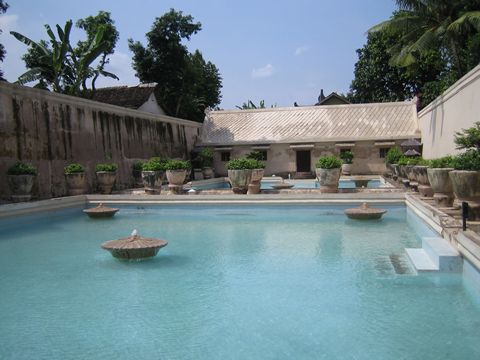
The Water Castle also serves as a meditating place for the Sultan to bear offerings to the Queen of the South Sea. This practice has been dutifully fulfilled since the beginning of the Hamengkubowono rule.
There is dark chamber where the Sultan supposedly still comes to meditate and fasts for three consecutive days before consummating with the Queen.
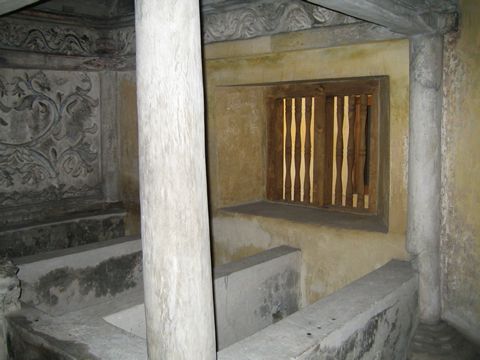
Meditation Chamber
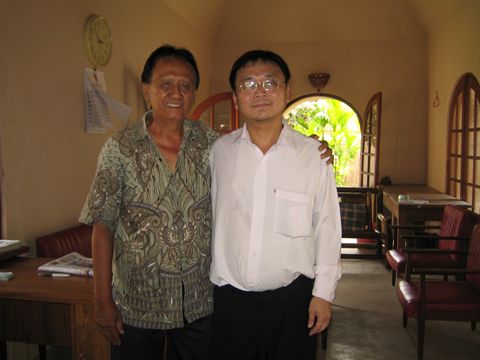
API Raymond with Wiyono, Taman Sari guide for 30 years, explaining about
Taman Sari and the links with Ratu Kidul
BEDOYO KETAWANG
The most holy dance of the kraton of Solo, the Bedoyo Ketawang, is showed only once a year to celebrate the day that the sultan ascended the throne. Nine dancers in classical Jawanese bridal dressing envite Ratu Kidul to appear and marry the susuhunan. As it is told, the goddess appears as a slightly visible tenth figure at the floor of the nine dancers. The Yogyan version of this dance, the Bedoyo Semang isn't performed anymore.
(The Kingdom of Mataram actually become divided into the Hamengku Buwono family based in Yogyakarta and the
Pakuwubono family based in Solo in the 18th century). Up until recently, the dance is not open to public.
The Bedoyo Ketawang court dance depicts the courtship of the founder of the Mataram dynasty, Panembahan Senopati, with Kangjeng
Ratu Kidul. The annual dance performed on the anniversary of the Sultan's coronation reaffirms the alliance of the ruling house with the powerful
goddess.
When Pakuwubono XII died in 2004, there is a fight for succession between two princes among his 24 children from his 5 concubines, resulting in two coronations.
One of the prince Hangabehi have the advantage of having the Bedoyo Ketawang performance for him and is now recognised as Pakuwubono XIII

The late Pakuwubono XII (seated on the right) at a Bedoyo Ketawang dance
The Sacred Dance of Bedoyo Semang, Picture card 1860
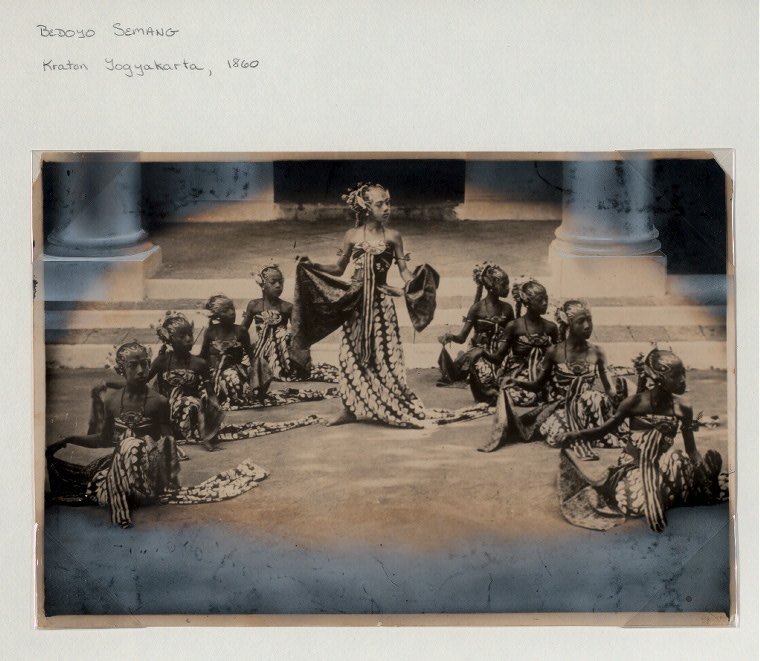
For the detailed story on the divided royalty in Solo, see http://www.theage.com.au/news/general/divided-royalty/2005/09/30/1127804661710.html
It is believed that The King of Mataram and the Queen of the Southern Ocean composed the lyrics of
the song and the movements of the dance to repeat the passion of Ratu Kidul for her original
Mataram lover, Panembahan Senopati, and—through performance—to reactualize that
passion in her serial sexual/metaphysical unions with each of her successive lovers, these
"kings of the last age. The song, in essence, sings and thus is meant to realize the (erotic
and other) potency of Javanese kingship.
After the old kingdom of Mataram was split into the two realms of Surakarta and Yogyakarta. Over the succeeding
years, the serial rulers of each of these realms have claimed to enjoy a special
relationship with the Queen of the South. After the split, the Bedoyo Ketawang devolved
upon the Surakarta Karaton; while Ratu KiduΓs "other" sacred dance, The Bedoyo
Semang, fell to Yogyakarta. In early 1985, some four hundred years after Ratu KiduΓs
original liaison with Panembahan Senopati, the central portion of the Karaton Surakarta
burnt to the ground. Some witnesses to the fire, claiming to see Ratu Kidul dancing in the
flames over the main pavillion as it crashed to the ground, interpreted the fire and her dance
as the queen's final desertion of the Mataram dynasty—as the end of the last age. And yet
not three months after the fire, the reigning Susuhunan Pakubuwono XII was again ritually
reenacting the old alliance, sitting enthroned on an alternate throne in an alternate
throneroom before yet another performance of the empowering Bedoyo Ketawang. Again
in late 1988, with the death of Yogyakarta's beloved Sultan Hamengkubuwono IX, rumors of
the imminent possibility of the discontinuation of Ratu KiduΓs relationship to Yogyakarta
kingship were rife. But when the late Sultan's son succeeded to his father's throne in March
1989, the local and national presses were full of stories implying Ratu KiduΓs invisible
presence in the young king's "coronation coach.
The lyrics: The initial section is composed in the impassioned and sometimes describes the richly adorned figure of a Javanese hero
setting forth—as if to battle—on (or perhaps from) an erotic encounter.
This second section, the most arcane of the song, is written almost entirely in
the form of wangsalan. The riddles evoke the depth of Kangjeng Ratu KiduΓs passion for
Panembahan Senapati and his royal successors, as well as the profundity of her despair and
sorrow upon separation from these her serial lovers.
The final section of the song sings Ratu KiduΓs praises for the
sexual, political, and ultimately metaphysical potency of her lovers, the Susuhunan.
A Translation of the Bedoyo Ketawang Lyrics
I
Your brother has sounded the signal
You are left behind
O Father, give the sign
Then the signal sounded
In ever clashing clamor
All along the way mad with love
Clad in fine white trousers, in skirts of deep red hue
With dark green silken belt
With gold encrusted kens
Brilliant diamond earrings
Set in fine gold filagree
Frangipanni blossoms
Of redolent fragrance sweet
With flowing sash of cindhe silk, adorned with golden bracelets
Yea, annointed with fragrant balms
[His] golden diadem studded
With rarest precious jewels
And gracing his ears, gossamer wings of gold
Frangipanni blossoms bright
So redolent of fragrance sweet
Π.
Heart veiled with care, when [we together ] lay parted by a pillow
Earth-descended gods aflank a mighty gate
All is lost—the pillow lies fallen on the floor
O mighty Susuhunan
Who then shall take pity on the transport of [my] love?
Light of the world, flower of enlightenment:
Manifest bright are but thou in the bed
O mighty Susuhunan
The enthralling arrow soars to oblivion in soulful love
Secreted deep within the heart; ever may [I] fall before the Sunan's feet
The allure of his approach stirs my heart
Little frog, thou tilarsa leaf
Be [thou] calmed; to whom then does [my]self belong?
0 mighty Susuhunan
O! Never once risen let [it] set again
Show me how to serve [thee] 1 shall beg to lie beneath [thy] feet perhaps
Were it manifest in truth I would fall sick
Perhaps [I would] go mad
Susuhunan
When, O Mighty Lord, shall I meet [thee] In the bed, O Mighty Lord?
Seat of the soul, little lake-borne lotus bloom
When lost in longing, whither must [I] call?
All thy scions, O Mighty Lord—Ah! in the bed
Blinded by tears is she Dhangur
[Her] body wholly yielded, it is but sorrow in the end
[And] to stand with head held high means but sorrow in the end
There is no meeting save surrender body and soul.
IΠ.
O! His beauty, may a thousand be his wives
As if
His crimson sash is edged on either side
The Susuhunan
Wanders, many are his wives
The Susuhunan
As if
Wandering, many are his queens
The Susuhunan
As if
Jewels strewn among the clouds
The Susuhunan
His power is like the stars
Weeping [I] gaze upon the heavens
As if
Like the stars, thy works, Panembahan
The arrow's shaft, like fire its blaze
A rage of flames, My Lord
Should death come, where in shall it steal, My Lord?
Source : Nancy K Florida, The Badhaya Katawang: A translation of the song of Kangjeng Ratu Kidul
Additional notes on the Hotel Bali Beach Fire on Jan 1993

On 20 Jan 1993, Inna Grand Bali Beach, formerly known as the Grand Bali Beach, was largely destroyed by a massire fire. The fire consumed the entire main building and all but one of the 600 odd rooms. Strangely enough room no 327 of the 3rd floor was not burnt at all, with intact interior and only darkened walls.
API finds there are 2 versions about this room 327.
One version involved the late president Sukarno:
Room 327 is special. It’s the room the Balinese believe that Roro Kidul, their mythical Goddess of the South Seas, allocated to Sukarno, independent Indonesia’s father. The hotel was gutted in the 1993 blaze but room 327 was the only one of 600-odd that survived wholly intact.
Even today, the room is maintained in the vernacular of the era even though Sukarno never stayed in the hotel. His trademark black peci and white trousers lay on the bed. No one stays in the room but it’s cleaned daily. On August 17, Indonesia’s Independence Day, Balinese deliver cakes coloured the red and white of the national flag.
Another version:
There is a spiritual medium that can communicate with Ratu Kidul. Before the fire, the medium, having received a message from the Queen, ask the Bali Beach Hotel to reserve 2 rooms for the Queen, Room 327 and Room 2401. If the hotel management did not accept this request, she will punish the hotel. A deadline was set of 42 days for the hotel to comply.
After 42 days have passed, the hotel management did not act at all. On 20 Jan 1003, around 12.10 pm, Fire suddenly occured at the 10 storey tower building. Due to the strong wind from the sea, the fire burned rapidly and spread. Afer the fire died down the next day, it was found there is only one room that was not burnt. It was the room Ratu Kidul have asked for :Room 327. The other room 2401 was not on the tower building but a cottage room beside the tower building and so was not affected by the fire.
According to an eye witness who saw the room after the fire, "I still cannot believe it until now, all the surrounding rooms are totally burnt, but fire did not touch this room. Outside the room, everything is burnt. It is as if the wind comes from the middle of the room and blow out the fire"
After the fire, 7 months later, the hotel was renamed Inna Grand Bali Beach, and this time, the hotel management reserved Room 327 and Room 2401 especially for the Queen to rest.
API note: Although some other hotels also reserved room for the Queen, only the room at Samudra and the room at Bali Beach is considered sacred.and blessed with the presence of Ratu Kidul.
References:
http://www.jawakidul.nl/where.htm – Many Links
http://royjava.eigenstart.nl/ – Many Links
http://www.mikalina.com/Texts/pelabuhanratu_indonesia.htm – A Resort with a Ghost
http://www.ne.jp/asahi/pasar/tokek/TG/KNRK/main.html – Japanese website with pictures of Bali beach room 2401